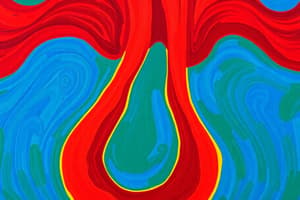Podcast
Questions and Answers
Which class of anticoagulants directly blocks thrombin?
Which class of anticoagulants directly blocks thrombin?
- Parenteral Direct-acting anticoagulants (correct)
- Oral Direct-acting anticoagulants
- Antiplatelet agents
- Indirect-acting anticoagulants
What is a notable advantage of using Dabigatran over warfarin?
What is a notable advantage of using Dabigatran over warfarin?
- Requires regular PT-INR monitoring
- Higher risk of thrombosis
- Lower cost than warfarin
- No significant drug-food interaction (correct)
Which of the following is NOT a use of Indirect-acting anticoagulants like Heparin?
Which of the following is NOT a use of Indirect-acting anticoagulants like Heparin?
- Direct blockade of factor Xa (correct)
- Management of acute coronary syndrome
- Management of pulmonary embolism
- Immediate effect before starting warfarin
What defines the mechanism of action (MOA) of indirect-acting anticoagulants?
What defines the mechanism of action (MOA) of indirect-acting anticoagulants?
Which indirect-acting anticoagulant has no monitoring requirements?
Which indirect-acting anticoagulant has no monitoring requirements?
Which component is primarily involved in promoting platelet aggregation during the first phase of hemostasis?
Which component is primarily involved in promoting platelet aggregation during the first phase of hemostasis?
What is the end product of the second phase of hemostasis that strengthens the clot?
What is the end product of the second phase of hemostasis that strengthens the clot?
Which glycoprotein is most important for binding platelets together through fibrinogen?
Which glycoprotein is most important for binding platelets together through fibrinogen?
What role does Antithrombin III (ATIII) play in the coagulation process?
What role does Antithrombin III (ATIII) play in the coagulation process?
Which factor is involved in the activation of prothrombin into thrombin in the coagulation cascade?
Which factor is involved in the activation of prothrombin into thrombin in the coagulation cascade?
Flashcards are hidden until you start studying
Study Notes
Hemostasis Overview
- Hemostasis consists of cellular (primary) and protein (secondary) events that contribute to blood clot formation.
Primary Hemostasis
- Involves platelets (thrombocytes) and is characterized by platelet aggregation and migration.
- Key components of platelet aggregation:
- Pro-aggregants lead to clot formation:
- Thromboxane A2 (TXA2)
- Adenosine diphosphate (ADP)
- Serotonin
- Anti-aggregants prevent clotting, promoting bleeding:
- Prostacycline (PGI2)
- PGE2
- cAMP
- Pro-aggregants lead to clot formation:
- Glycoproteins play crucial roles in platelet interaction:
- Glycoprotein 1A (GP1A): Facilitates binding to collagen.
- Glycoprotein 1B (GP1B): Connects platelets to von Willebrand factor (vWF).
- Glycoprotein IIB/IIIA: Forms bridges between platelets using fibrinogen.
- The final product of primary hemostasis is a weak platelet plug known as White Thrombus.
Secondary Hemostasis
- Strengthens the initial platelet plug through the blood coagulation cascade.
- Converts fibrinogen into fibrin to form a stable clot.
- Clotting factors exist in two forms:
- Inactive (zymogens): Factors I, IV, III, V, etc.
- Activated: Factors IA, IVA, IIIA, VA, etc.
- Activation pathways:
- Extrinsic and intrinsic factors converge to activate factor X into Xa.
- Factor Xa converts prothrombin (II) into thrombin (IIA).
- Thrombin activates fibrinogen (I) into fibrin (IA), forming a stable clot.
- The end product is Fibrin, resulting in Red Thrombus for effective clotting.
Regulatory Mechanisms
- Plasmin: Active form derived from plasminogen through tissue plasminogen activator (tPA); plays a role in fibrinolysis, thereby promoting bleeding.
- Antithrombin III (ATIII): Inhibits thrombin (IIA) to control bleeding.
- Protein C & S: Inhibit factors VA and VIIA within the intrinsic pathway to prevent coagulation.
Antithrombotic Agents
- Categorized into two main classes to prevent clot formation:
- Antiplatelet Agents: Affect cellular processes of platelet binding.
- Anticoagulants: Impair protein event processes within the coagulation cascade.
Anticoagulant Medications
-
Direct-acting anticoagulants:
- Block thrombin (IIA) directly.
- Include parenteral options:
- Hirudin: From leech saliva; watch for hypersensitivity.
- Lepirudin: Recombinant version; first-line for heparin-induced thrombocytopenia (HIT).
- Bivalirudin: Used in acute thrombosis after angioplasty.
- Argatroban: Second-line for HIT.
- Oral options:
- Dabigatran: Alternative to warfarin for atrial fibrillation, DVT, vascular thromboembolic disorders; no food interactions or PT-INR monitoring but risk of bleeding.
-
Indirect-acting anticoagulants:
- Mechanism of action involves destruction of clotting factors.
- Include parenteral types:
- Heparin:
- Unfractionated heparin (UFH) or Low molecular weight heparin (LMWH).
- LMWH examples: Enoxaparin, dalteparin.
- Immediate effect used for WARFARIN initiation and various coagulation disorders (e.g., DVT, acute coronary syndrome).
- Heparin:
- Monitoring:
- UFH: Requires aPTT monitoring.
- LMWH: No monitoring necessary.
Additional Considerations
- Pregnancy: Anticoagulants can be used judiciously, with specific considerations for safety.
Studying That Suits You
Use AI to generate personalized quizzes and flashcards to suit your learning preferences.




